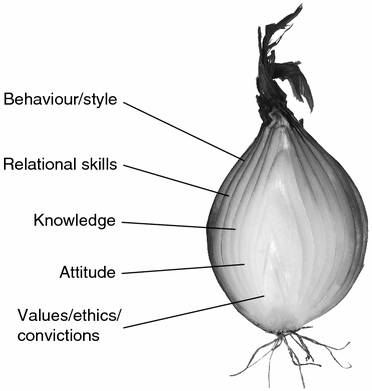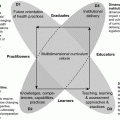- Personality
Personality is made up of the characteristic patterns of thoughts, feelings and behaviours that make a person unique. It arises from within the individual and remains fairly consistent throughout life.
De Haan and Burger (2004) outlined the structure of personality, which can be described as an onion, in Figure 6.1.

Figure 6.1 A structure of personality (De Haan & Burger, 2004) Reproduced with permission from De Haan & Burger.
They believe that values are developed over time as a result of experience and the influence of others. Behaviours can be more easily modified and developed, but all of these personality aspects can affect the interactions and engagements that take place with others.
Life skills
Life skills are the skills that we acquire through experience; some can be taught or encouraged but most are learnt through our experiences. Life skills are wide and varied but examples include:
| • Employability skills; | • Time management; |
| • Transferable skills; | • Empathetic skills; |
| • Listening skills; | • Conflict resolution; |
| • Problem solving; | • Communication skills; |
| • Stress management; | • Numeracy and literacy; |
| • Social skills; | • Study skills; |
| • Customer service skills; | • Financial skills; |
| • Parenting skills; | • Anger management. |
Applying personal skills to dementia care
When working in dementia care, a professional is often working closely with the individual and often over several years. This means that not only does the professional know the client very well but a trusting relationship has developed. Recognising when you need help not only on a professional basis but also on a personal basis can help you to help the client.
This simple checklist, modified from the one provided by the Family Caregiver Alliance (2015), can be used for any health care professional as well as the carer of a person with dementia:
An interprofessional team can support not only the client but each of the professionals in the team. The following case study outlines a situation where various members of the interprofessional team need to consider not only their professional roles in helping the person with dementia but also how they pass information between each other.
- Interprofessional
The terms ‘interprofessional education/practice/teamwork’ etc. have been defined by various groups. These terms are often used interchangeably. Where we simply use the term ‘interprofessional’, we do so when two or more professions are working collaboratively together.
Jade Cartwright, Curtin University, Australia
Marie is a speech pathologist with four years’ clinical experience working in a range of hospital and community health care settings. Twelve months ago she joined a specialist dementia assessment and care unit that provides diagnostic assessment and management for people with dementia. The unit is made up of an interprofessional care team, including a neurologist and psychiatrist, clinical psychologists, neuropsychologists, social workers, occupational therapists and speech pathologists. The team regularly consults with community physiotherapists, dieticians, pharmacists and other health professionals on a needs basis.
Marie is currently working with a particularly complex client, Beth, a 78-year-old lady who lives at home alone in the community. Beth was widowed seven years earlier and her only daughter lives in London. She has a small group of friends whom she socialises with regularly. Beth presented to the unit with a three-year history of progressive speech difficulties, characterised by difficulty finding words and effortful, hesitant speech output. She was otherwise fit and healthy with no other medical complaints. She had described her symptoms to her GP on a number of occasions. However, she continued to perform well on the Mini Mental State Examination. She was referred to a specialist, but her symptoms were thought to be related to depression and anxiety associated with her husband’s death. She was prescribed an antidepressant medication but her language symptoms persisted.
Beth remained certain that something more sinister was wrong and self-referred to the dementia assessment and care unit. She was seen by the team’s neurologist and a neuropsychologist. Following extensive investigations and a series of cognitive assessments, a working diagnosis of primary progressive aphasia (PPA) was made. This diagnosis was met with some initial relief by Beth, providing as it did an explanation for her symptoms. However, she was upset to hear that the condition had no cure and was progressive in nature. Beth had not heard of aphasia or PPA before and was eager for more information about the condition.
PPA is a relatively rare dementia syndrome that targets the language networks of the brain (Mesulam, 1990; 2000). Symptoms are confined to the language domain for a period of at least two years, during which time individuals retain strong insight and awareness of their condition, and retain abilities in other areas of cognition such as memory, attention, visuospatial skills and executive functions (Mesulam, 2000). This was consistent with Beth’s clinical presentation. She had acute insight into her speech difficulties, and remained independent in all activities of daily living that were not dependent on language. For example, she was able to clean, cook simple meals and complete personal care tasks independently, while continuing to manage all of her own financial affairs and medical appointments at home. She continued to drive and access the community without assistance. Beth’s speech, however, was becoming progressively less fluent and effortful, with frequent word-finding hesitations. She described difficulties formulating language with sudden blockages, which she found incredibly frustrating. As a result, she was experiencing significant trouble speaking over the phone, running errands and making enquiries in the community, as well as participating in social conversation with her friends. Beth had made the decision not to talk to her daughter or friends about her diagnosis at that time as she did not want to worry or burden them.
After these initial appointments at the unit and receiving the diagnosis, Beth was referred for speech pathology assessment and ongoing management. Marie became Beth’s case manager and was seeing Beth at home on a weekly basis to provide education and support. They quickly formed a strong rapport and Beth was thankful that Marie understood the nature of her speech difficulties and appreciated her genuine concern. Marie provided Beth with a range of word-finding strategies and communication aids, which Beth used willingly during speech sessions and conversations with Marie, with some positive effect. For example, Beth’s written expression was more preserved than her verbal expression and she was often able to write words or short phrases that she was unable to say or recall verbally during conversation. Despite their effectiveness, Beth did not want to use these strategies in the community or with family and friends, and was attempting to mask her speech difficulties as much as possible.
About two months into their sessions, Marie was becoming increasingly worried about Beth’s psychological status, suspecting that she was struggling to come to terms with her diagnosis. Beth had begun withdrawing from social interactions, was not eating and was losing weight. Beth also reported difficulty sleeping, and was lying awake at night worrying about her speech difficulties and the future. Beth acknowledged that she was embarrassed and ashamed of her speech difficulties, and felt that she was of little use to anyone if she was unable to talk. Beth was struggling to see that she had any residual strengths or positive qualities to draw upon.
Although Beth’s primary symptoms and emotional reactions were related to her speech difficulties and PPA, Marie realised that she did not have the expertise to provide the counselling and support that Beth currently needed. Furthermore, Marie was starting to feel incredibly drained from the weight of Beth’s concerns and was finding that she was lying awake at night herself trying to come up with practical solutions for her. As Beth’s speech pathologist, Marie felt incredible pressure to support her client’s communication and lessen the emotional distress that she was experiencing. Given the progressive nature of Beth’s condition, Marie was also concerned for Beth’s future and her psychological state in the long term.
Stay updated, free articles. Join our Telegram channel

Full access? Get Clinical Tree





